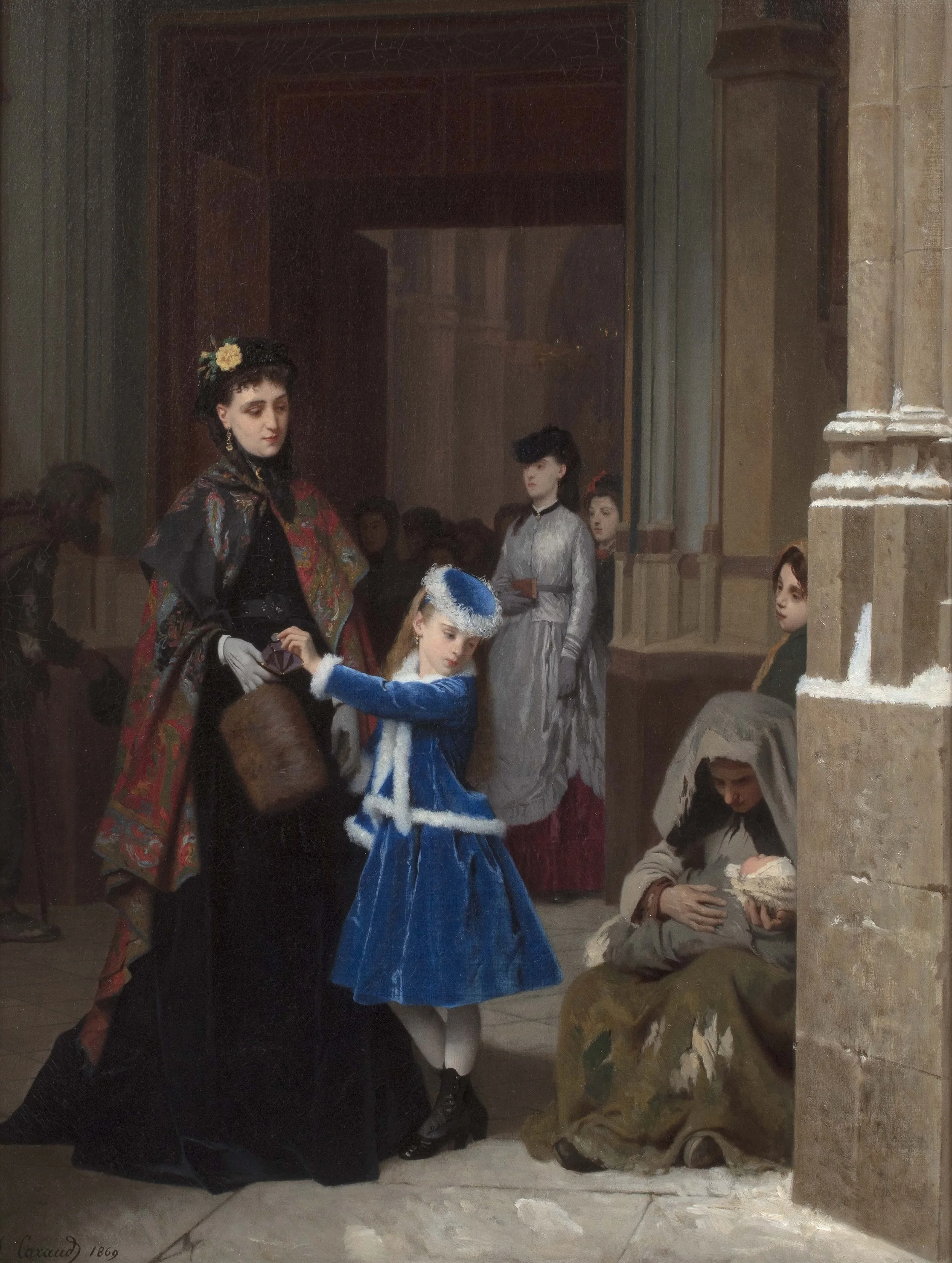JOSEPH CARAUD (Cluny 1821 - Lyon 1905)
The Alms Giver (L’ Aumône)
Signed and dated J. Caraud 1869 in the lower left
oil on canvas
24 x 19 inches (61.5 x 49 cm.)
PROVENANCE
Anonymous sale, Parke – Bernet Galleries, Inc. New York, November 12, 1970, lot 60, where acquired by
Private Collection, New Jersey, until the present time
EXHIBITED
Paris, Salon, 1870, no. 465
LITERATURE
Salon de 1870, Charles de Mourgues Frères, Paris, p. 60, no. 465
“The Paris Fine Art Exhibition” in The Architect, volume III, London, May 7, 1870, p. 221
Camille Lemonnier, Salon de Paris 1870, Veuve A. Morel & Compagnie, Paris, 1870, p. 173
“Genre“ in Journal Général de L’Imprimerie et de La Librairie, volume xv, Paris, 1871, p. 409
“Kunstfachen” in Borsenblatt fur den Deutschen Buchhandel, volume 2, Leipzig, July – December 1872, p. 2712
“Photographie (Cartes de Visite) – L’aumône” in Catalogue Général de la Maison Boussod, Valadon & Cie, Paris, November 1886, p. 103, no. 1222
“J. Caraud, L’aumône” in Buch – und Kunst-Katalog, Gesammt-Verlags – Katalog des Deutschen Buchhandels, volume xv, Adolph Russell’s Verlag, Munster, 1886, p. 446, no. 1222
“Joseph Caraud“ in Dictionnaire Général des Artistes de L’École Française, Louis Auvray, Librairie Renouard Supplément, 1887, p.120
H. W. Janson, Catalogues of the Paris Salon 1673 – 1881, volume 1870, Garland Publishing, Inc., New York & London, 1977, p. 60, no. 465
Pierre Sanchez and Xavier Seydoux, “Salon de 1870” in Les Catalogues des Salons des Beaux – Arts, volume IX, L’Echelle de Jacob, Paris, c. 1999 – 2014, p. 60, no. 465
REPLICATION
Carte de Visite by Goupil & Cie, Paris, no. 1222
The Paris winter of 1869 is depicted in The Alms Giver. An elegant crowd of women are viewed leaving a cathedral after mass. An exquisitely dressed mother and daughter have stopped to give alms to a wretched family. The sunken eyes of the poor girl are mesmerized by the fur trimmed, royal blue velvet attire of her young benefactress. Joseph Caraud who typically confined himself to lighter genre or historical fare, marked by women in sumptuous dress, deftly uses his skill to define the enormous gulf between the two families creating an indelible image that is heart-wrenching. Further it is a direct plea to the viewer not to forget those who are less fortunate.
When The Alms Giver was exhibited in the 1870 Salon it was no longer eligible to win any awards. Having received prizes in the previous Salons of 1859, 1861 and 1863, Caraud had been given the hors concours classification in 1867 which excluded him from the competition. It did instead afford him the right to be automatically included in the Salon with his work exempt from examination by its jury. This system was implemented to give younger artists an easier chance of obtaining medals, and it is the reason why after a certain point the artist’s medal count at successive Salons became irrelevant.[1] Yet The Alms Giver was singled out by the press as a work not to be missed at the Salon, reproduced in photographic prints for the general public to acquire, and made into a Carte de Visite by Goupil & Cie.
An example of this card is in the Collection Goupil in the Musée d ’Aquitaine, Bordeaux. Such cards were typically an albumen print on thin paper glued onto a thicker paper card measuring about 4 ½ x 2 ½ inches. They were patented in Paris in 1854 by the photographer Andrè Adolphe Eugène Disdèri. By the 1860s they were hugely popular, widely collected throughout Europe, compiled into albums, and proudly displayed in homes, in a photographic phenomenon dubbed “Cartomania”.[2]
Paintings by Caraud such as The Alms Giver were regarded as “petits chefs – d’oeuvre” (small masterpieces). His works were generally admired for the elegance of his figures with lovely faces and brilliant color, along with a softness of touch. He is further described as constantly walking the streets of Paris to sketch and record contemporary life,[3] and perhaps The Alms Giver was inspired by something witnessed on one of these walks. Caraud began his training in 1844 at the Ecole des Beaux Arts, Paris studying with Alexandre Abel de Pujol and Charles – Louis Lucien Müller. Prior to that in 1843 he had already made his debut at the Salon with two entries, a Portrait of M. G. and La bonne – maman et la petite fille (The Good Mother and Little Girl). Throughout his career he concentrated on painting scenes of genre often from the period of Louis XV. His subjects from 1848 – 1851 reflect his travels in Italy and Algiers. In 1867 he was made a Chevalier of the Legion of Honor, the highest and most prestigious French order given to both military and civilian recipients.[4]
Works by the artist can be found in the Musée des Beaux – Arts de Carcassonne, France; The Baltimore Museum of Art, Maryland; The Lauren Rogers Museum of Art, Laurel, Mississippi; and the Museum of Art, Rhode Island School of Design, Providence, Rhode Island.
[1] Harris C. White, Canvases and Careers: Institutional Change in the French Painting World, The University of Chicago Press, Chicago, 1993, pp. 31, 47.
[2] “Carte-de-Visite” at National Portrait Gallery, npg.org.uk.
[3] Felix Jahyer, “Joseph Caraud” in Galerie Contemporaine, Libraire D’Art de Ludovic Baschet, Paris, 1879, unpaginated.
[4] Biographical information taken from E. Benezit, “Joseph Caraud” in, Dictionnaire des Peintres, Sculpteurs, Dessinateurs et Graveurs, volume 2, Libraire Gründ, Paris, 1976, p. 513.
